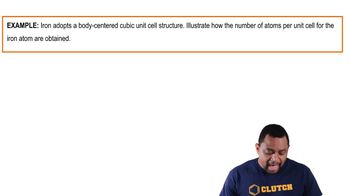Textbook Question
Explain why silicon carbide–reinforced alumina is stronger
and tougher than pure alumina.
343
views
 Verified step by step guidance
Verified step by step guidance



A group 3A metal has a density of 2.70 g/cm3 and a cubic unit cell with an edge length of 404 pm. Reaction of A 1.07 cm3 chunk of the metal with an excess of hydrochloric acid gives a colorless gas that occupies 4.00 L at 23.0 °C and a pressure of 740 mm Hg. (a) Identify the metal.
A cube-shaped crystal of an alkali metal, 1.62 mm on an edge, was vaporized in a 500.0 mL evacuated flask. The resulting vapor pressure was 12.5 mm Hg at 802 °C. The structure of the solid metal is known to be body-centered cubic. (c) What are the densities of the solid and the vapor in g>cm3?